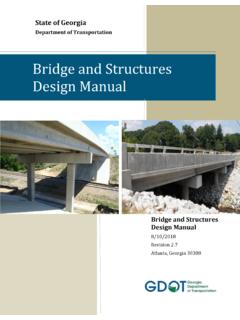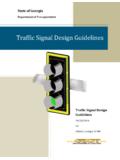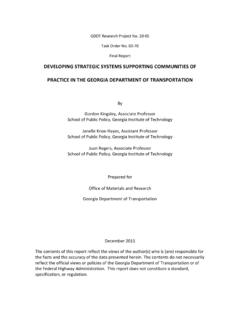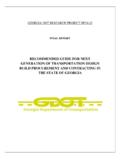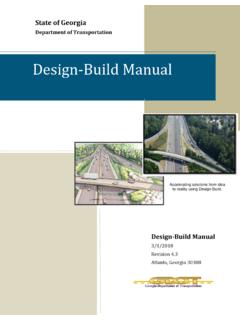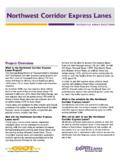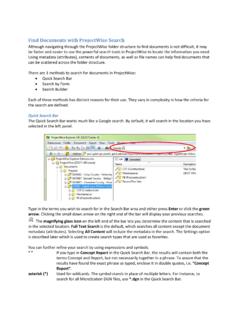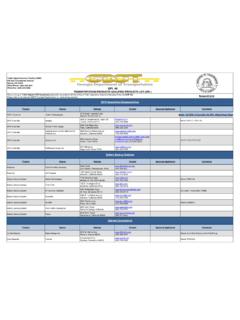Transcription of Standard Guideline for the Collection and Depiction of ...
1 Standard Guideline for the Collection and Depiction of Existing Subsurface Utility Data CI/ASCE 38-02 ABRIDGED VERSION: For a complete copy visit Guideline for the Collection and Depiction of Existing Subsurface Utility Data Contents INTRODUCTION SCOPE DEFINITIONS engineer AND OWNER Collection AND Depiction TASKS engineer Project Owner UTILITY QUALITY LEVEL ATTRIBUTES Quality Level D Quality Level C Quality Level B Quality Level A DELIVERABLES FORMATTING General Basic Deliverable Quality Level Attributes Utility Depiction Legend Examples of Mapping Deliverables RELATIVE COSTS AND
2 BENEFITS OF QUALITY LEVELS Cost Savings Costs INFORMATION SOURCES APPENDIX: SURFACE GEOPHYSICAL METHODS FOR UTILITY IMAGING ABRIDGED VERSION: For a complete copy visit Guideline for the Collection and Depiction of Existing Subsurface Utility Data INTRODUCTION The nation s infrastructure continues to grow as a result of population growth and other factors. New technologies are proliferating, such as fiberoptics, which are replacing copper communication cables. In addition, the deterioration and replacement of existing structures have expanded activities dealing with the utility infrastructure.
3 The effort to clean up the environment has necessitated considerable excavation in areas of high-density infrastructure development. Available right-of-way is becoming limited, especially in urban and suburban areas. The footprint of new construction, repair, or remediation often conflicts with existing infrastructure. When this existing infrastructure is hidden from view ( , buried), it is often discovered in the construction phase of a project. During this phase, the costs of conflict resolution and the potential for catastrophic damages are highest.
4 Existing subsurface utilities and their related structures constitute a significant portion of this infrastructure. They create risks on projects. Inaccurate, incomplete, and/or out-of-date information on the existence and location of existing subsurface utilities reduces the engineers , owners , and contractors abilities to make informed decisions and to support risk management decisions regarding the project s impact on existing utilities. A convergence of new equipment and data-processing technologies now allows for the cost-effective Collection , Depiction , and management of existing utility information.
5 These technologies encompass surface geophysics, surveying techniques, computer-aided design and drafting and geographic information systems, and minimally intrusive excavation techniques. This convergence of technologies and systematic use of the data derived from these technologies is known as subsurface utility engineering (SUE). Organizations such as the Department of Transportation, the National Transportation Safety Board, the Department of Energy, Associated General Contractors of America, Inc., universities, and utility companies are endorsing the use of SUE.
6 The engineer s job in collecting and depicting utility information is complicated by the relatively limited control over utility owners record data. The utility owner is typically under no obligation to the engineer to provide information. The engineer is therefore often unable to obtain available and pertinent utility information. Utility owners are obligated under statute in most states to mark the location of their known active facilities on the ground surface just before construction. This is often too late for design purposes or for contractor bidding purposes.
7 A very few states have laws that encourage utility owners to mark facilities at the time of design; however, utility owners are under no legal requirement to do so. Some utility owners may desire to mark their facilities for the engineer . For reliable information during design and construction, the engineer , owner, and constructor should be certain that utilities, active, abandoned, or unknown, are identified; that the utilities are marked correctly; that the numbers of actual utility pipes or cables under the ground are known or represented by multiple marks; that the width of facilities is correct; and that the depths of utilities are known.
8 Reliable information has historically not always been provided by utility owners. Engineers may have received, made, or obtained a mixture of evidence of the existence, character, and location of utilities. Evidence may vary widely as to its credibility. Application of this Guideline and the establishment of a credible nomenclature system will permit affixing attributes to utility information that denote the quality of that utility information. Problems with existing utilities are routinely handled through change orders, extra work orders, insurance payouts, and contingency pricing.
9 When problems create ABRIDGED VERSION: For a complete copy visit costs, the finger of blame is pointed everywhere, including at the engineer who has affixed his or her stamp to the plans, regardless of disclaimers. All involved in the design and construction process will benefit from better information for the management of risk. SCOPE The scope of this document is a consensus Standard for defining the quality of utility location and the attribute information that is placed on plans. The Standard Guideline addresses issues such as (a) how utility information can be obtained, (b) what technologies are available to obtain that information, and (c) how that information can be conveyed to the information users.
10 The intent of this Standard Guideline is to present a system of classifying the quality of data associated with existing subsurface utilities. Such a classification will allow the project owner, engineer , constructor, and utility owner to develop strategies to reduce risk by improving the reliability of information on existing subsurface utilities in a defined manner. This document, as a reference or as part of a specification, will assist engineers, project and utility owners, and constructors in understanding the classification of the quality of utility data.
